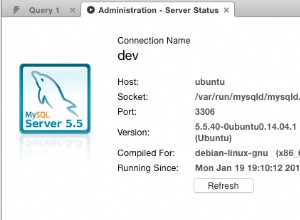Ten konkretny przypadek
Poniższa funkcja dynamicznie tworzy widok na podstawie tabeli:
create or replace function create_totals_view(table_name text)
returns void language plpgsql as $$
declare
s text;
begin
execute format ($fmt$
select string_agg(format('star_pu->>''%s'' "%s"', key, key), ',')
from (
select distinct key
from %s, json_each(star_pu)
order by 1
) s;
$fmt$, '%s', '%s', table_name)
into s;
execute format('
drop view if exists %s_view;
create view %s_view as
select date, total_list_size, %s from %s',
table_name, table_name, s, table_name);
end $$;
Najpierw utwórz tabelę z zapytania.
create table totals as
SELECT date,
AVG(total_list_size) AS total_list_size,
json_object_agg(key, val) AS star_pu
FROM (SELECT date,
SUM(total_list_size) AS total_list_size,
key, SUM(value::numeric) val FROM frontend_practicelist p,
jsonb_each_text(star_pu)
GROUP BY date, key ) p
GROUP BY date
ORDER BY date;
Następnie użyj funkcji, która utworzy widok nazwany po tabeli z _view przyrostek:
select create_totals_view('totals');
Na koniec zapytaj o widok:
select * from totals_view;
Uogólnione rozwiązanie (dla jsonb)
create or replace function create_jsonb_flat_view
(table_name text, regular_columns text, json_column text)
returns text language plpgsql as $$
declare
cols text;
begin
execute format ($ex$
select string_agg(format('%2$s->>%%1$L "%%1$s"', key), ', ')
from (
select distinct key
from %1$s, jsonb_each(%2$s)
order by 1
) s;
$ex$, table_name, json_column)
into cols;
execute format($ex$
drop view if exists %1$s_view;
create view %1$s_view as
select %2$s, %3$s from %1$s
$ex$, table_name, regular_columns, cols);
return cols;
end $$;
Użycie:
create table example (id int, name text, params jsonb);
insert into example values
(1, 'Anna', '{"height": 175, "weight": 55}'),
(2, 'Bob', '{"age": 22, "height": 188}'),
(3, 'Cindy', '{"age": 25, "weight": 48, "pretty": true}');
select create_jsonb_flat_view('example', 'id, name', 'params');
select * from example_view;
id | name | age | height | pretty | weight
----+-------+-----+--------+--------+--------
1 | Anna | | 175 | | 55
2 | Bob | 22 | 188 | |
3 | Cindy | 25 | | true | 48
(3 rows)




